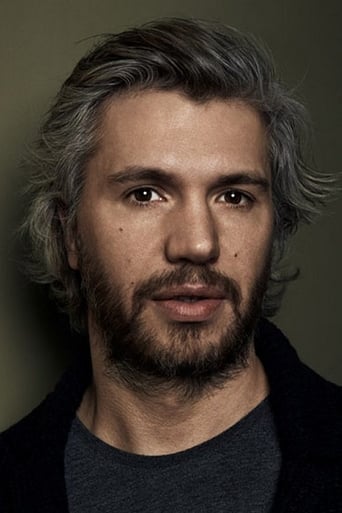Mjeteconer
Just perfect...
VeteranLight
I don't have all the words right now but this film is a work of art.
Erica Derrick
By the time the dramatic fireworks start popping off, each one feels earned.
Zandra
The movie turns out to be a little better than the average. Starting from a romantic formula often seen in the cinema, it ends in the most predictable (and somewhat bland) way.
SimonJack
This multi-language film was made in Norway and celebrates a genuine hero of the Norwegian underground from World War II. Many films have been made about the French underground and resistance movements in other countries, including Norway. Only since the fall of the Iron Curtain (circa 1990), has the Western world been able to see some of the fine movies made about WW II in Eastern European countries. While an occasional WW II movie is still made in America, European war films tend to be superior since the turn of the 21st century. One would expect that to be the case with the nations where the war was fought. The memories, records and stories aren't so soon forgotten in the places where people lived through the horror, fear and oppression, and so many lost their lives.A few very good films have been made about Norwegian resistance. The earliest of those, "The Day Will Dawn" (aka, "The Avengers"), was made and released in Great Britain in June 1942. "Commandos Strike at Dawn," was a Columbia movie that came out Dec. 30, 1942. It was shown in the United Kingdom and the Americas in 1943. It made theaters in neutral Sweden in March 1944. "The Moon is Down" was a 1943 film by 20th Century Fox. It is about the German takeover of a Norwegian mining town, and the local resistance to the Nazis. These are among the best of the Norwegian underground movies. "Max Manus: Man of War" joins that list. This is a Norwegian film about a hero who led a life rife with killing for a war effort. It was made in 2008, a little over a decade after Manus died. It is one of the very best of all films made about Nazi resistance during World War II. This is an easy film to follow with English subtitles. The cast will mostly be little known west of the pond, but all do very well. Aksel Hennie is superb as Max Manus. Hennie portrays Manus as a man who loved his native country and was willing to fight to free it – even to death. But he also shows the emotional battles that Manus struggled through. He has flashbacks about killing an enemy soldier in Finland. He weeps over friends who are killed. And, he makes cold calculating decisions for actions that may kill innocent people. So, this film shows the inner turmoil and struggles over killing. Manus was something of a soldier of fortune before WW II. He had traveled to and worked in the jungles of South America and Latin America. The film shows his volunteer fighting for Finland in 1939-40 when Russia invaded that country. The film can't show all of the story, obviously, but before Manus got to England and Scotland for training, he was in the U.S. and Canada. When the USSR entered the war, Manus escaped from Norway east across Scandinavia to Russia, then down to Turkey and by ship to Capetown and on to America. He began training in the U.S. and Canada before crossing the Atlantic to England. The film has a nice ending, as it really happened, with Manus riding in a victory car as the main guard to the prince of Norway. He was attracted to his British embassy contact in Stockholm, Tikken Lindebraekke. At the end of the movie, she goes off with her husband and daughter. In real life, Manus and Tikken were married in 1947. After the war, Manus had a successful office supply company. He had frequent nightmares and bouts of depression with alcoholism. He wrote books about his earlier adventures and the war, and gave interviews. He lived to age 81, and died Sept. 20, 1996, in Spain. He and Tikken moved there after retiring.In spite of some of the technical aspects of this film, I rate it highly. The jumpiness of the cam shots is distracting and doesn't help the film. The plot does skip too abruptly in places, and I suspect that is due to some cutting during the edit to keep the film from being too long. Still, because of the detailed treatment of the Norwegian resistance surrounding this one man and his cohorts, I give the movie nine stars. It gives a real-life picture that we haven't seen in many resistance films set during WW II.
Sindre Kaspersen
Norwegian film producers and directors Espen Sandberg and Joachim Rønning's second feature film which was written by Norwegian screenwriter Thomas Nordseth-Tiller, is inspired by real events in the life of a 20th and 21st century Norwegian author, resistance fighter and lieutenant of Norwegian Independent Company 1. It premiered in Norway, was screened in the Gala Presentations section at the 34th Toronto International Film Festival in 2009, was shot on locations in Norway and Scotland and is a Norway-Denmark-Germany co-production which was produced by Norwegian producers John M. Jacobsen and Sveinung Golimo. It tells the story about a Norwegian citizen of Norwegian-Danish origins in his late 20s named Maximo Guillermo Manus who after voluntarily having fought the Russians on Finnish side in The Winter War (1939-1940), joins a Norwegian clandestine resistance movement in Oslo, Norway with a group of like-minded men named Gregers Gram, Gunnar Sønsteby, Kolbein Lauring and Sigurd Jacobsen which starts by writing newspapers. Distinctly and engagingly directed by Norwegian filmmakers Espen Sandberg and Joachim Rønning, this finely paced and somewhat fictional tale which is narrated by the main character, from multiple viewpoints and mostly from his point of view, draws a consistently involving and reflective portrayal of one national hero and true servant of the country of Norway who was born in Bergen, Norway in 1914, who was baptized Roman Catholic, who dropped out of school as a fourteen-year-old and went to live with his uncle in Cuba, who made a living by selling flowers in Chile and who on the 9th of April, 1940 in the capital city of Norway had to witness the German invasion of Norway with his friends. While notable for its atmospheric and variegated milieu depictions, reverent and commendable cinematography by Norwegian cinematographer Geir Hartly Andreassen, production design by Icelandic production designer and costume designer Karl Júliusson, costume design by Danish costume designer Manon Rasmussen and use of sound, this character-driven and narrative-driven story about friendship, patriotism as opposed to nationalism, appreciation and privilege of peace and of the men who honored the history of this nation, depicts an affectively heartrending study of character and contains a great and timely score by composer Trond Bjerknæs. This densely biographical, historic and majestic war epic and quiet love-story from the late 2000s which is set in Finland, Norway, Scotland, England and Sweden in the late 1930s and early 1940s, which reconstructs historical events like few Norwegian films ever has and where a soldier whom is in the midst of planning and executing sabotage missions against the Germans meets a married Norwegian woman named Ida Nikoline Lie Lindbrække Bessesen, is impelled and reinforced by its fragmented narrative structure, substantial character development, rhythmic continuity, multiple perspectives, poignant use of flashback and depiction the aftermath of war, unprecedented scenes between Max and Tikken which creates a contrasting light to the horrors caused by the Second World War, the unforgettable acting performances by Norwegian actor Aksel Hennie and Norwegian actress Agnes Kittelsen and the good acting performances by Norwegian actors Nikolai Cleve Broch, Christian Rubeck and German actor Ken Duken. An important and insightful narrative feature.
WakenPayne
Let me make one thing perfectly clear. I walked into this movie knowing almost nothing about Max Manus and only knew somewhat about what he did. I think that might be the key into whether you're going to really enjoy this movie or not. I did like it but it does have problems.In case you don't know Max Manus was one of the best Norwegian Resistance fighters in the second World War. This movie seems to be Chronicling all of that while he must confront his alcoholism and nerve damage. Would this make way for a good movie? In my opinion Hell yes. It would probably make way for one of the best of it's kind but this does have problems.The biggest gripe for me is that the people who made this movie are shoe-horning in a lot of things for a near 2 hour movie. It kind of skips quite a bit. An example is when Max's best friend Gregers dies. That could show some great drama for what he would be going through... In the next scene it's a few months later. Sometimes when this happens it even skips almost a year. I know almost nothing about this guy is there really nothing they could have shown that would have been just as interesting as what we've already seen. I mean they cut from Max escaping Nazi control by crossing to the Swedish border to him getting trained in Scotland almost a year later. You know what I wouldn't have minded it if the time length was extended to three hours or so.I did like how some of the drama was handled though. While this movie does skip over some things I did like how the post-war scene was handled when Tikken and Max are talking when Max says he has no education, no job and no money and therefore has nothing to live for. There are some scenes like that when I did like the way it was handled.I also liked the acting and the cinematography of this movie. All of the cast do a pretty good job at acting the parts and some of the shots are actually quite impressive to look at. In terms of cinematography I guess I enjoyed the flashbacks to Max fighting on the Front Line in Finland the most.So I guess if you want to watch this movie - I think you should do a little homework on this guy before you watch it, he does actually sound like an interesting guy to look up. Some of the scenes are handled pretty well and others aren't. This is a decent movie to watch but I don't think it's as good as people are saying it is.EDIT: Now that I have done some research on the real guy... Why didn't they include some of these events in this film?
mongatu
I'm not much for reviewing films but since most of the reviews are from Norwegians, I just wanted to add an American's perspective that I thought this film was really excellent in all respects. I fully agree with most of the favorable comments made by the Norwegian reviewers. This was a great heroic true war story, with plenty of action, tension, suspense, romance, great acting, production values, screenplay, cinematography . . . everything just great. The film convincingly made me feel as if I really was transported back to that time and place and the tensions of the circumstances of being in the resistance and living under Nazi occupation.Although I don't think it messed up the story at all, I did wonder whether it was historically accurate to depict the saboteurs using those light colored oars on one of their outings to plant limpet mines and also not having their faces camouflaged because it really made them stand out in the lights at night. I suppose they had to be able to easily blend back into the local civilian scene immediately upon getting back to shore so that may account for the faces, but those light colored oars really looked amateurish. But if it was historically accurate, then fine. I'm just curious about that. Anyway, this is a very minor point that in no way detracts from what was a great movie and very enjoyable and gripping film from start to finish. It's not just for Norwegians. I highly recommend it to any non Norwegian speaker who doesn't mind subtitles.






